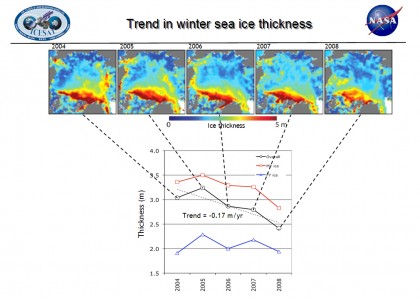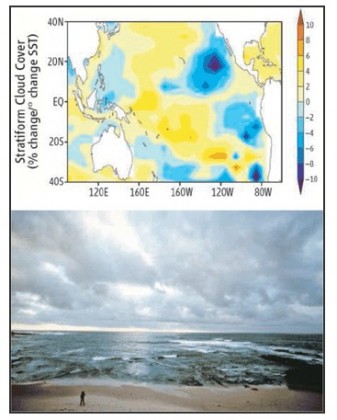26 July 2009
Clouds & Ice Make Climate News
Posted by Dan Satterfield
This last week brought an update on the Arctic sea ice from the NSIDC folks. It also saw the publication of a paper in SCIENCE that made almost all of us who follow climate science, sit up and notice. Neither is particularly good news, and that may be an understatement.
First the ice- or lack of same.
2007 saw the lowest amount of Arctic Ocean ice on record. I happened to be in the High Arctic in August (The record low was reached the following month). We traveled down a hundred plus miles of the fabled NW Passage and saw very little ice at all. The sudden drop in 2007 stunned the science world. The best guess of the IPCC were that the Arctic ocean would not be substantially ice free in Summer until around 2090. Those days are gone.
At the current rate of melt, the ice may be mostly gone by 2050 and some scientists are betting 2040.
It’s not just the coverage of ice that is changing. Far more dramatic in my opinion is the changes in thickness. The thicker ice that survives for multiple summers is disappearing. This is a strong indication that the summer melt will accelerate quickly.
What will the September bring? It’s looking more and more as if we may approach the 2007 melt. We are already running ahead of last years near record.
It is important to understand that the ice will not just drop a little more each year. There are many factors that govern how much ice melts each year. Ocean currents, and prevailing winds are two of the most important. The year to year fluctuations are caused by weather. The long term decline is caused by Climate.
Now onto clouds..
The affects that clouds have on our climate is one of the least understood aspects of climate. While you may think that clouds act to reflect the suns energy and act to cool the planet, this is not always the case. Clouds at night, trap heat in. Thin cirrus clouds actually cause warming and a deck of low clouds in daytime does act to cool the planet.
Someone told me awhile back, that we did not need to worry about climate change because as the earth got warmer, the oceans would evaporate more and the extra clouds would cool us right down. (and we did all that radiation Physics for nothing!)
Most climate models have assumed that clouds will increase a bit and act to cool as we warm up. This is a negative feedback. If the paper published in Science this week is right, the truth is just the opposite!
Amy Clement from the Univ. of Miami and others have published the results of a detailed study of clouds over the Pacific. Using surface and satellite records, they found that as the ocean warmed, the clouds DECREASED! This is a positive feedback. Fewer clouds will allow more sun in, causing more warming and even fewer clouds.
They found that the one climate model that seems to show this best is the Hadley Center model in the UK. It’s one of the main models and is known for having a higher sensitivity.
The Climate sensitivity is defined as the warming we would expect for a doubling of the CO2 levels. The IPCC has given a range of 2.5C to 4.0 C for this and you will often see the mid range of 3C quoted in mass media. We will likely reach this doubling in 40-60 years. If Clement and her fellow authors are right, the climate sensitivity might be closer to the Hadley model at 4C.
This would mean that we have less time to reduce our emissions, and the goal of holding the warming to 2C, will be very difficult to reach. Even with more massive cuts in emissions than we thought. Note the IPCC will still be correct (albeit at the upper range) in their forecasted climate sensitivity!
Science does not deal in certainties, the language of science is probability. Even if we were to reach the emissions goals set out by politicians at the G8 awhile back, we would still have a 50% chance of exceeding 2C. And, that is if Clement et al. are wrong!
I told you the news wasn’t good.





 Dan Satterfield has worked as an on air meteorologist for 32 years in Oklahoma, Florida and Alabama. Forecasting weather is Dan's job, but all of Earth Science is his passion. This journal is where Dan writes about things he has too little time for on air. Dan blogs about peer-reviewed Earth science for Junior High level audiences and up.
Dan Satterfield has worked as an on air meteorologist for 32 years in Oklahoma, Florida and Alabama. Forecasting weather is Dan's job, but all of Earth Science is his passion. This journal is where Dan writes about things he has too little time for on air. Dan blogs about peer-reviewed Earth science for Junior High level audiences and up.